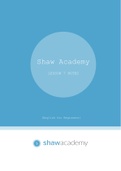Class notes
Class notes of English diploma(part7,8)
- Institution
- English For Academic Purposes
This is a bundle of professional English diploma's part 7and 8 which marks the end of the professional diploma. If you haven't checked on the previous documents then please do download them first to make your base strong and complete this course. PART 7: this will equip you with all the skills yo...
[Show more]



